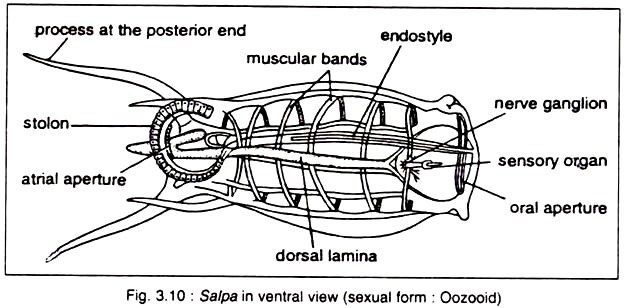In this article we will discuss about the structure of nucleosome.
When chromatin or whole chromosomes are spread on an air-water interface and examined in the electron microscope, fibers 250 Å in diameter are observed. These are de-oxy-nucleoprotein fibres in which DNA is complexed with protein.
Removal of proteins by various methods reveals the 10 nm fibre (1nm = 10 Å), the ultimate subunit of chromatin. Pronase digestion of the 10 nm fibre leaves a DNAse sensitive 2 nm fibre which contains the single DNA double helix.
It is now well known that only a small fraction of eukaryotic chromatin is transcribed (active chromatin) in a particular nucleus while most of it is silent (inactive chromatin). In 1973 Miller and Beatty devised a technique for observing active transcribing chromatin in the electron microscope.
Two kinds of active regions have been recognised: the nuclear regions coding for rRNA and the non-ribosomal cistrons. The active chromatin shows nascent RNA molecules on a DNA axis (lampbrush or Christmas trees) separated by non-transcribed spacers.
The inactive chromatin shows a beads-on-a-string appearance called the nucleosome. In 1974 when Olins and Olins applied Miller’s technique to chicken erythrocytes, they found numerous fibres with regular knob-like structures released out of the nuclei. The name nu bodies was given to the beaded structures. Oudet, Gross-Bellard and Chambon (1975) observed similar beads in chromatin prepared from many vertebrate tissues and introduced the term nucleosome.
Nucleosomes are present in all the eukaryotic cells studied, in plants and animals and in mitotic and polytenic chromosomes. The bead and the connecting string (seen in Fig. 19.7) constitute one repeat unit. Structurally it contains about 200 base pairs (bp) of DNA and all the 5 histones.
The bead contains about 140 bp of DNA wound in two complete super-helical turns around a protein core which consists of 2 molecules of each of the histones H2A, H2B, H3 and H4. About 60 base pairs of DNA are present in the connecting string with which the histone H1 is associated. The term core particle has been used for the bead, and linker region for the thin connecting filament.
Thus the DNA in chromatin (Fig. 19.8a) is packaged into a series of repeat units; each repeat unit consists of two distinct parts, a core particle and a linker region (Fig. 19.8b), Chromatin from widely different species such as protozoa, lower and higher eukaryotes has shown that the core particle has a constant length of DNA of about 140 bp; but the linker length is variable within the same tissue and in different species. The nucleosome model for chromatin substructure is attractive because it explains the packaging of long strands of DNA into smaller repeat units (nucleosomes).
Biochemical analyses of chromatin have supported the nucleosome concept. When chromatin is digested with micro-coccal nuclease, it produces oligomeric DNA fragments of specific lengths which correspond with the repeat unit observed in EM. The core particles are most resistant to degradation by nuclease and the linkers are the most nuclease sensitive regions.
X-ray diffraction and neutron scattering studies of crystallized DNA fragments have also established the existence of nucleosomes. A combined X-ray diffraction and EM study by Finch (1977) has shown that the nucleosome core particle is disc-like with dimensions of 110 Å x 110 Å x 57 Å. It consists of double helical DNA wound around a core of histone proteins with a super-helix pitch of about 28A. It is calculated that each core particle is associated with 1.75 turns of DNA.
Although it is often stated that nucleosomes are present in inactive, non-transcribing chromatin, there are some conflicting reports on this aspect. EM observations have shown the absence of nucleosomes at the sites of rRNA transcription.
However, nucleosomes have been observed in chromatin regions involved in non-ribosomal RNA synthesis. Some studies on the structure of chromatin have shown the presence of nucleosomes in both active and inactive chromatin.
The Supra-Nucleosomal Structures of Cromatin:
The question now is how is the nucleosome packed into the higher order structures (250 nm fibres) of chromatin? A close packing into a supra-nucleosomal organisation has been suggested. Chromatin fibres isolated from some materials show globular units or knobs about 200 Å in diameter.
There is evidence that the knob is a supra-nucleosomal bead containing on the average about 8 folded nucleosomes. Several investigators have suggested a helical arrangement of nucleosomes to form the higher order structure.
Finch and Klug have found a close packing of nucleosomes to produce a nucleofilament, a fiber about 100 Å in diameter. The nucleofilament is further coiled up to form the “solenoid” with diameter of 30-35 nm (Fig. 19.8). There are about 6 nucleosomes per turn of the solenoid coils.
The involvement of histone H1 in helical coils of the nucleosome has been suggested by some workers. According to Kornberg and Klug (1981), H1 leads to folding of the 10 nm fibre to form the solenoid. In Albert’s (1977) model direct interactions among the nucleosomes generate crystal packing forces which give stability to the helix instead of histone H1.
The involvement of non-histone proteins in nucleosome is not fully established. Comings (1979) has proposed a model in which the 250 Å fibre containing condensed nucleosomes is arranged into a series of loops or chromomeres by the association of DNA with non-histone proteins.

